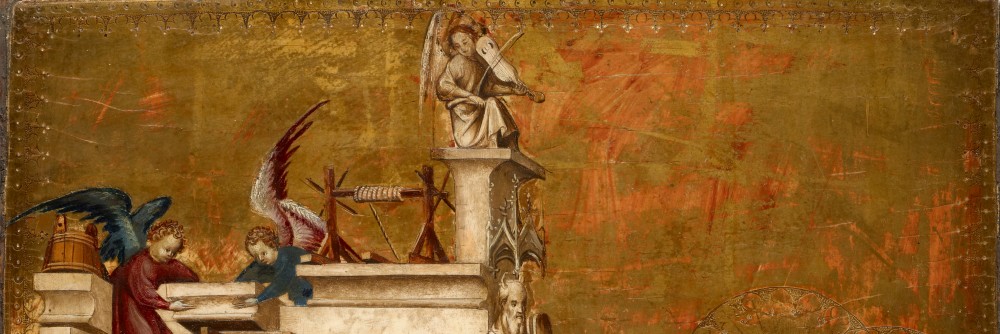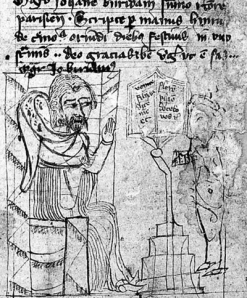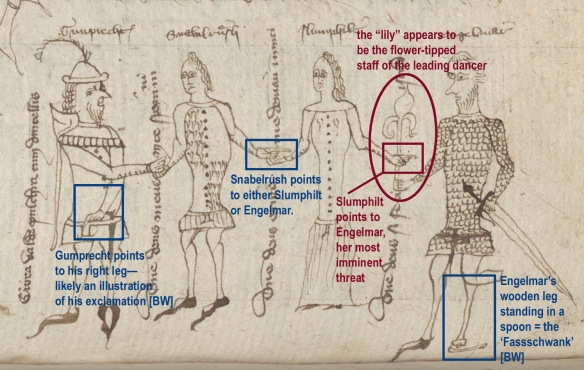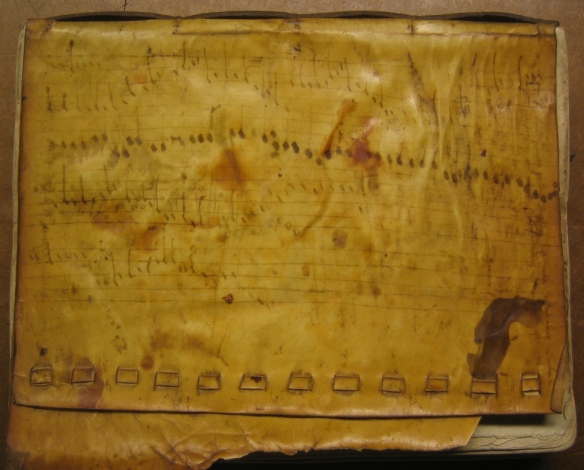[The findings of this blog post have since been contextualised in an essay for the Vienna research project “Musical Life of the Late Middle Ages in the Austrian Region (c1340-c1520)”: Das Phänomen “Neidhart” (German).]
The songs and stories of and around the author and personage “Neidhart” were well-integrated in late medieval Viennese cultural life. Having started as the œuvre of an extremely successful minnesinger in the early 13th century, who apparently came from Bavaria and at some point in his career moved to Vienna, his songs developed a life of their own and the dissemination of his work gained momentum until it became one of the central repertoires of secular song in the Austrian region of the 14th and 15th centuries. Its popularity is well documented in a plenitude of contemporary Neidhart-collections, some of them even with melodies. The topics which made his songs so popular and widespread also inspired the creation of images in dance or feast halls, depicting scenes and personnel from Neidhart songs: Favoured among these are rustic dance scenes and burlesque stories as well as the names of the most beloved characters from the songs. The frescos of Tuchlauben 19 in Vienna likely are the most important and well-known. These depictions were collected, presented and discussed in the monograph “Neidhartrezeption in Wort und Bild”, edited by Gertrud Blaschitz, which also includes on p. 110 a newly discovered Neidhart-ink drawing from Vienna University#. It went largely unnoticed until in 2011 Burghart Wachinger published an article where he gave a thorough analysis of the drawing*. It can fulfill the function of an important missing link, connecting the different traces of Neidhart reception to form a more coherent picture, which also involves the up to now largely neglected role of the university in the secular musical life of late medieval Vienna.
The following presentation gives an analysis of the ink drawing in codex A-Wn Cod 5455 (Vienna University, c.1370) based on Wachinger’s study and broadened by additional observations. Wachinger’s findings and readings are marked “[BW]” in the illustrations. All other readings apart from the transcriptions of the names of the Neidhart personnel, which were already given by Blaschitz, are by myself and Reinhard Strohm. Fol. 226r of the codex features two drawings which were inserted in the text of Jean Buridan’s (c.1300 – after 1358) comments on Aristotle’s “Physics”, the Questiones in Aristotetelis libros physicorum. The space for the drawings was left empty by a scribe who apparently assumed that he was missing the according amount of text. The hand holding a scroll with an abbreviated Latin rubric leads from the end of the text before the lacuna to its continuation in the next column, thus bridging the gap. The scroll reads: “hic nullus est defectus, hoc scias, lector”—”nothing is missing here, this you shall know, reader” (see Wachinger, “Neidhart im Bild”, p. 144). The space thus available on the page apparently was then filled with the two drawings: One of them presenting four figures, three of which appear in Neidhart songs, and another one with a university teaching scene, supporting the fact that the manuscript and the drawings belonged to university circles. The Neidhart figures are separated by verses, three of them being psalm quotations (Ps. 7,2; 30,16; 7,4—see Wachinger, “Neidhart im Bild”, p. 147). The lesson scene shows one “teacher” sitting on the cathedra and three “students”. Wachinger deciphered the name in the scroll next to the teacher as “Plato”, and the inscriptions next to the students as “Socrates”, “Cicero” and one “Rosarius”:
![Ink drawings on fol. 226r of Vienna University codex A-Wn Cod 5458—inscriptions deciphered by Blaschitz (Neidhart names), Wachinger [BW] and Lewon/Strohm. (photo with kind permission of the ©ÖNB)](https://musikleben.files.wordpress.com/2013/07/a-wn-cod-5458-fol-226r.jpg?w=584&h=774)
Ink drawings on fol. 226r of Vienna University codex A-Wn Cod 5458—inscriptions deciphered by Blaschitz (Neidhart names), Wachinger [BW] and Lewon/Strohm. (photo with kind permission of the ©ÖNB)
Moreover, this Kraków codex of Buridan’s Questiones was written by one Henricus de Cremona who himself was a student of the first rector of Heidelberg University, Marsilius von Inghen. Marsilius’ own teachings, however, can be found in another codex from Vienna University, which itself contains an entry of German monophonic music, and which was discussed in a previous blog entry: A-Wn Cod 5455, fol. 180v. It almost seems as if the depiction of the “teaching scene” could somehow be connected to the transmission of Buridan’s Questiones in German-speaking lands and that the gap in the text might have been left consciously in A-Wn Cod 5455, fol. 226r to insert the drawing. In any case, the net of interrelationships between university teaching materials and German monophonic song becomes ever more finely woven with these new findings.
The verses next to the Neidhart figures, apart from being allusions to the bible (in the case of the first one) and psalm quotations (in the case of the remaining three) are clearly assigned to the figures next to them:
“Crura valde pulchra cum domicellis“,
says Gunprecht (= Gumprecht) and points to his legs: “Very beautiful legs with maidens”. If we should have solved the abbreviated “domicellis” correctly, this could refer to the beautiful legs of the maidens dancing with the young men. The picture, however, only shows one of them (Slumphilt). Wachinger in turn transcribes this word as “dimicellis” and suggests that it is an unattested inflection of “dimiculus” = “sword” (Wachinger, “Neidhart im Bild”, p. 147). This interpretation nicely coincides with Gumprecht’s gesture towards his own legs and the fact that the Neidhart-villains, the “dörper”, tend to lose their legs in many of the Neidhart-farces (“Schwänke”), as the depiction of Engelmar with his wooden leg exemplifies. The name “Gumprecht” appears in only three Neidhart songs and in the “Greater Neidhart Play” (“Das Große Neidhartspiel”, D-W Cod. Guelf. 18. 12 Aug. 4°, fol. 274r-321v; 15th century, Southern Germany or Tyrol). Interestingly though, one of the songs is also contained in the Eghenvelder Liedersammlung (w4), which was written by a student of Vienna University c.1430. It is particularly noteworthy that this song also mentions field names and places around Vienna (Leobendorf, Tullner Gebiet, Marchfeld) as well as the dörper Engelmar who loses half his leg in a fight.
“Domine deus meus in te speravimus“,
says Snabelrúsh, who also is a known Neidhart character and who—like Gumprecht—appears only in a very small number of songs, two of which again can also be found in the Eghenvelder Liedersammlung (w6 and w12) from Vienna. Moreover, one of them (w6) features the dörper Engelmar, a village dance, the land of Austria and the statement that after a fight many of the dörpers lost half their legs. The other one is a farce-story and repeatedly mentions Engelmar, Zeiselmauer and Vienna. Another two songs featuring Snabelrúsh (alternative spellings are “Snabelraus”, “Snabelraws” and “Gnapelraus”) which survive in the Tyrolian Sterzinger Miszellaneen-Handschrift (s5 & s11) describe a dörper-fight, mentioning the Marchfeld and Zeiselmauer, both near Vienna. A “Schnabelrawss” also has a fairly substantial speaking role in the Greater Neidhart Play. This occurrence of the name bears further implications as will be shown below. His exclamation, taken from psalm 7,2, is slightly altered from “speravi” to the abbreviated plural “speravimus” (“Lord, my god, in you we trusted”) possibly to include the other dörpers and likely hinting at the multiple loss of limbs.
“Domine deus eripe me de manu inimici“,
begs Slumphilt, who—as Wachinger points out—does not appear anywhere in Neidhart’s œuvre and is altogether atypical, for Neidhart never uses derisive nicknames for female dörpers (see Wachinger, “Neidhart im Bild”, p. 147). The Neidhart farces, however, might have gone further by that time to include also this feature, which otherwise is not alien to 15th century brutish poetry such as the “Ring” by Heinrich Wittenwiler (the drawing in Wittenwiler’s manuscript being slightly reminiscent of the Vienna ink drawing, as well). Her name could be roughly translated as “Awry-Hild”. Her request, taken from psalm 40,15-16 and turned from the plural into the singular (“Lord god, save me from my enemy”) could be directed at Engelmar—the most notorious and ubiquitous of the dörpers—who is standing right beside her and to whom she appears to be pointing with her left hand. He in turn says:
“Domine deus si feci istud“,
by quoting psalm 7,4 which is only 2 verses away from Snaberúsh’s statement. His “Lord god, when I have done this…” sounds almost like an ominous threat and is immediately reminiscent of the ever-present antecedent of Engelmar snatching or even breaking the mirror belonging to the dörper-girl Friederun, a topic which is oft-quoted in Neidhart’s songs and which carries a several meanings; not the least of which can be interpreted as a sexual assault. Wachinger on the other hand interprets Engelmar’s statement as a comment on the flower he seems to be holding, which could be a reference to the Veilchenschwank (“violet-farce”), one of the most popular Neidhart themes, involving the replacement of a violet by a turd by some of the dörper (Wachinger, “Neidhart im Bild”, p. 147). Wachinger also notes, however, that the flower is depicted here as a lily. It may therefore be necessary to look for an alternative interpretation. Furthermore, Wachinger observes that Engelmar’s wooden leg standing in a spoon is a direct depiction of a very specific song, namely the Fassschwank (“barrel’s farce”), in which the Engelmar’s left leg is described to fit into a spoon, since it is replaced by a wooden leg now. The song also mentions pitiful Friederun, the broken mirror and the town of Zeiselmauer, near Vienna (see Wachinger, “Neidhart im Bild”, p. 147).
We are clearly looking at a dancing scene (Wachinger, “Neidhart im Bild”, p. 147) since all the protagonists are holding hands, even though some of them are at the same time pointing with one hand. Therefore, the scene in the ink drawing could be compared to other contemporary depictions of Neidhart dances, the most obvious being the frescos in Vienna’s Tuchlauben 19. Here the leading dancer, the “persevant”, carries a flower-tipped staff which is almost identical to Engelmar’s.
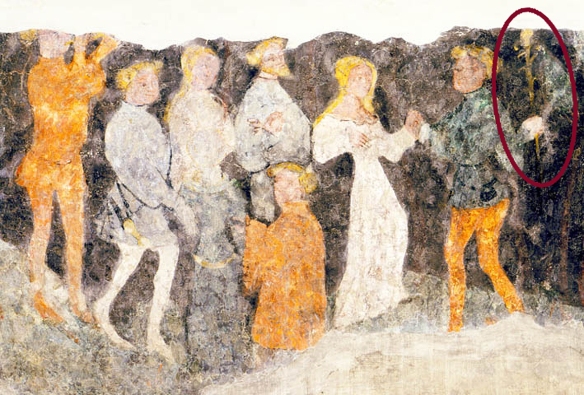
Neidhart fresco depicting a round dance in Tuchlauben 19, Vienna. The leading dancer holds a staff crowned with a lily.
Thus the flower in Engelmar’s right hand marks him as the leading dancer and seems to be a standard feature and not an invention by the illustrator of A-Wn Cod 5458:
However, both, the illustrator of A-Wn Cod 5458 and the fresco painter of Tuchlauben 19, may have combined the generic attribute of the persevant’s flower-tipped staff with a very specific Neidhart-topic: The “violet-farce” which was already mentioned above in connection with Engelmar’s flower, survives as a song with musical notation in two late manuscripts (D-Bsb 779, fol. 148v-149v & Vipiteno/Sterzing, Stadtarchiv, s.s., fol. 47v-48r. In the last strophe it says that Neidhart (as his lyrical self) returns to the peasants (dörper) to take his revenge and finds them at a dance. This dance scene is further embellished in other versions of the farce, including another one (without notation) in the aforementioned Vipiteno manuscript (on fol. 38r-39r), and in the late print “Neidhart Fuchs” (Augsburg 1491-97), which contains stories from Neidhart songs and farces. In both versions the dörper not only enjoy themselves at a dance, but celebrate their victory over Neidhart by dancing around the very violet which they had previously “stolen” from underneath his hat, thus enhancing the taunt (Vipiteno, fol. 39r: “Der vail stack awff ainer stangen“—“the violet was sitting upon a pole”). In “Neidhart Fuchs”, this scene is depicted in a woodcut which is somewhat reminiscent of the “Dance around the Golden Calf” but also bears a haunting resemblance to the Vienna ink drawing with four of the peasants holding hands and dancing around the violet on a pole. The “violet-pole” stands exactly between the leading and the second dancer, just as the flower-tipped persevant’s-staff stands between Engelmar and Slumphilt in the ink drawing:
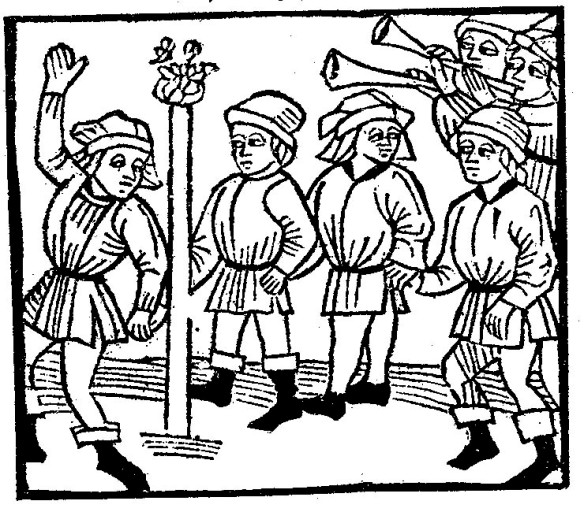
“Neidhart Fuchs”, printed in Augsburg, ca. 1491-97—depiction of the dörper’s dance around the captured violet from Neidhart’s Veilchenschwank (“violet-farce”).
After having arrived at the peasant’s dance Neidhart starts to fight them—with dire consequences for the dörpers as the last strophe concludes (verbatim from the song version in Vipiteno, fol. 48r): “Ir warn czwen vnd trißig / die verlorn doch ir tencke pain” (“there were thirty-two of them all of whom lost their left leg”)—a detail of the story which might have been reflected in the ink drawing by supplying Engelmar with a wooden left leg. I therefore surmise that apart from a generic depiction of a round dance led by a persevant with his staff and a passing reference to the Fassschwank (“barrel’s farce”—in which Engelmar explicitly looses his leg), the Vienna ink drawing (A-Wn Cod 5458, fol. 226r) might more specifically refer to the peasant’s dance around the violet from Neidhart’s Veilchenschwank (“violet-farce”). This connection is deepened by one of the rare occurrences of the name “Snabelrúsh” in the Greater Neidhart Play in which the violet-story plays a large part.
Nevertheless, the situation depicted in the ink drawing from A-Wn Cod 5458 seems not to be savely attributable to one single Neidhart song or story. Maybe the solution lies in their combination: Several Neidhart-farces which seem to be quoted in the drawing also appear in the Greater Neidhart Play (esp. the “violet’s farce” and the “barrel’s farce”), where a number of them are incorporated into an overarching narrative. Likewise, the ink drawing might not have meant to depict one specific tale, but a generic Neidhart-“medley”, the individual aspects of which could have been encountered in the course of a typical Neidhart play of the time.
However, even if the situation in the ink drawing cannot be linked to any specific song or combination of stories, the multiple allusions to a number of songs, farce-stories and plays—all of which take place in or around Vienna and are transmitted in sources from Lower Austria—firmly link the drawing to a repertoire which must have been well-known in the city and especially in university circles; the latter connection being strengthened by the musical notation found on the cover of the very same codex: Musical scribbles which are reminiscent of German monophonic song, especially of the surviving Neidhart melodies, and which feature a rhythmic principle that can also be found in some transmissions of Neidhart songs from the Eghenvelder Liedersammlung—the alternating “reference rhythm” (“long-short-long-short”, etc.), which seems to have a connection to the musical representation of dance:
By piecing together the different strands of evidence a multifaceted picture of Neidhart’s role in late medieval Viennese musical life emerges: The depictions in Tuchlauben 19, the place names in Neidhart’s songs, the university ink drawing with its musical scribbles on the cover, the Neidhart grave at the cathedral of St. Stephan, the transmissions of his songs in local song collections (most prominently the Neidhart songs in the Eghenvelder Liedersammlung) and finally the performance of Neidhart plays in the Austrian region together create a mosaic of a colourful Neidhart reception in and around Vienna.
Marc Lewon
 This work is licensed under a Creative Commons Attribution-NonCommercial-ShareAlike 4.0 International License.
This work is licensed under a Creative Commons Attribution-NonCommercial-ShareAlike 4.0 International License.
# Gertrud Blaschitz and Barbara Schedl, ‘Die Ausstattung eines Festsaales im mittelalterlichen Wien. Eine ikonologische und textkritische Untersuchung der Wandmalereien des Hauses “Tuchlauben 19”’, in Neidhartrezeption in Wort und Bild, Medium Aevum Quotidianum (Krems, 2000), 84–111.
* Burghart Wachinger, ‘Neidhart-Schwänke im Bild’, in Lieder und Liederbücher. Gesammelte Aufsätze zur mittelhochdeutschen Lyrik (Berlin; New York: Walter de Gruyter, 2011), 137–159.
+ Olaf Pluta, ‘Ewigkeit der Welt, Sterblichkeit der Seele, Diesseitigkeit des Glücks – Elemente einer materialistischen Philosophie bei Johannes Buridan’, in Historia Philosophiae Medii Aevi. Studien zur Geschichte der Philosophie des Mittelalters, ed. by Burkhard Mojsisch and Olaf Pluta (Amsterdam/Philadelphia: Grüner, 1991), ii, 847–872.
